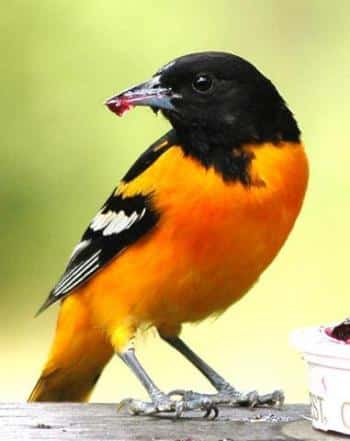Big, Bright Birds

Baltimore Oriole
Photo credit: Jim Williams
by Val Cunningham
Contributing Writer
Returning migrants stand out in brilliant orange, red or blue coats as they settle in and advertise for a mate.
Migratory birds will soon flood into our region, eager to begin their annual rituals of selecting a territory and finding a mate. Many will stop only briefly on their way farther north, including most of the tiny warblers that flit quickly over bark and leaves in the hunt for high-energy insect larvae.
Several kinds of flycatchers, most of them on the small side and dressed in taupe or olive-colored plumage, hunt from tree perches for flying insects for a quick meal. Other early spring migrants also include the sweet-singing (but drab) thrushes and the fast-flying swallows.
But I have to admit a fondness for the return of big, flashy birds, the visible ones that couldn’t blend in with the foliage even if they tried.
The bright orange-and-black Baltimore oriole, about the size of a cardinal, settles on the top of a tree, frequently near water to whistle his beautiful song. Males often engage in territorial disputes, chasing each other to and fro, making themselves even more conspicuous. These handsome birds are among the migrants that stop and raise their young in the metro area, and are known for their intricately woven nests hanging at the end of a branch.
Another good-sized bird shows up suddenly at feeders starting in mid-May. The handsome rose-breasted grosbeak, one of the sweetest singers on the block, sports a black back, white front and a rose-red bandana around its neck. You have to look closely for these cardinal-sized birds, though: even with such a high-contrast coat they can be strangely difficult to find.
A burry song from a tall tree signals the scarlet tanager’s return. About the size of a cedar waxwing, the tanager is an almost unbelievably neon-red bird. You won’t confuse it with a cardinal because tanagers lack a crest and their red is so much more intense. The tanager’s all-black wings are another distinguishing mark that says, “I am so not a cardinal.”
Spring is such a noisy season, filled with exuberant bird sounds, that it’s sometimes a challenge to single out one particular song. Especially if the singer knows up to 2,000 sounds, as the brown thrasher does, and links them together in always-varying melodic phrases. You’ll often find this large (blue jay size) cinnamon-colored bird with a very long tail at the top of a tree, running through his repertoire, or hunting insects on the ground.
Indigo buntings are due back soon from the Caribbean and Mexico to settle into fields and roadsides. The small and beautiful deep blue males, about the size of a goldfinch, can perch invisibly right over your head They only stand out in sunlight, when their feather structure reflects the light as a brilliant blue.
Billions of birds are winging into North America, eager to carve out some real estate as their own. They risk the often long, and always arduous, migration in order to take advantage of our region’s bloom of summer insects and longer days for foraging. They’ll stuff these down their youngster’s gullets, raise them fast, and by the time fall rolls around, be ready to head southward for another winter.
Enjoy the migrant birds while you can, knowing that these purposeful creatures are with us for only a short while each year.
St. Paul, Minnesota resident Val Cunningham, leads bird hikes for the St. Paul Audubon Society and writes about nature for local, regional and national newspapers and magazines.



